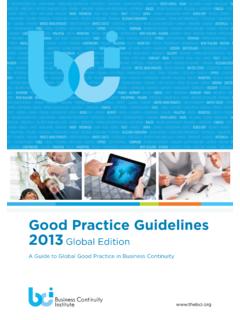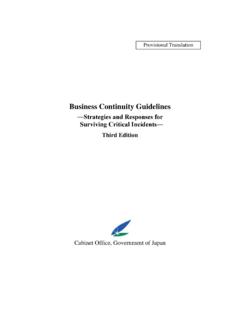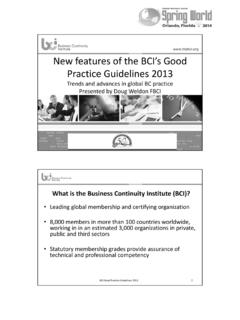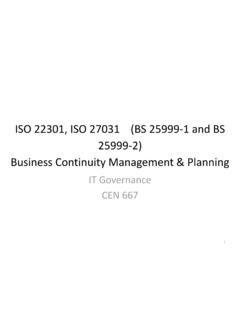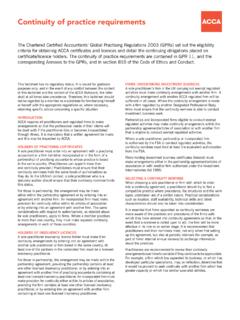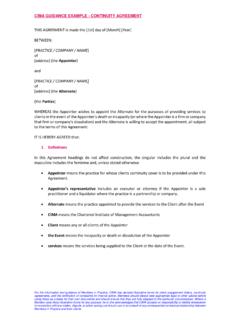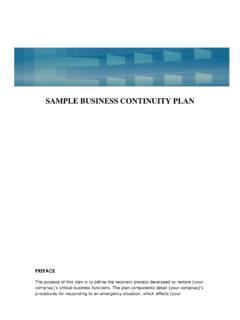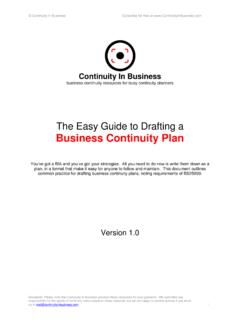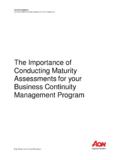Transcription of BS 25999 a framework for resilience and success - EFECTUS
1 BS 25999 a framework for resilience and success Robert Whitcher BCI Webinar June, 2009. 2. Scope of Presentation The Standards process Drivers for BCM and BS 25999 . BS 25999 development Overview of BS 25999 Part 1. Break Overview of BS 25999 Part 2. Certification Conclusions 3. What is a Standard? What is a Standard? A full consensus of all interested parties, so not imposed (includes Government, business, trade associations, Non Government Organizations and consumers). Updated on a regular cycle Best practice not general practice, therefore a goal Certification or audit is available, if required Standards pyramid ISO. European Standard ISO/PAS. National Standard Publically Available Specification Private Standard Company Codes of practice 5. The standards process Starts with formation of a Technical Committee (TC). after recognition of business need.
2 All interested stakeholders invited to join the TC. Work programme agreed with input from the National or International standards body TC can operate purely for National Standards or can mirror European and ISO committees Draft standards go for public consultation Emphasis is on building consensus among key stakeholders about what is best practice 6. Why formal standards Standards are a powerful tool for organizations of all sizes, supporting innovation and increasing productivity. Effective standardization promotes forceful competition and enhances profitability, enabling a business to take a leading role in shaping the industry itself. Standards allow a company to: Attract and assure customers Demonstrate market leadership Create competitive advantage Develop and maintain best practice 7. Why a formal standard We live in a more uncertain world with new and evolving risks Ensuring the survival of an organization is a top management priority More Board awareness of business disruptions and their impact on profits Organizations have far more interdependency between countries Organizations rely on longer and more risky supply chains and frequently rely on single-source suppliers 8.
3 Why a formal standard Provides a common framework , based on internationally accepted best practices for implementing and managing business continuity Provides a framework for organizations of any type, size and location Improve operational effectiveness of an organization Allows for the proactive management of business risks Help demonstrate applicable laws, regulations and contractual requirements are being observed Brings a common understanding to the marketplace 11. BS 25999 Part 1. 14. PAS 56. Predecessor to BS 25999 Original BCM Lifecycle Developed in conjunction with: The Business continuity Institute (BCI). Insight Consulting, and British Standards Institution (BSI). Published March 2003. Now withdrawn 15. BS 25999 -1:2006. Code of practice for business continuity management Establishes the BCM processes, principles and terminology Provides a basis for understanding, developing and implementing business continuity within organizations of any size or from any sector Provide a comprehensive methodology based on BCM.
4 Best practice and the whole BCM lifecycle Business driven 16. Benefits of BS 25999 . Provides a common framework , based on international best practice, to manage business continuity Proactively improves your resilience when faced with disruptions to your ability to achieve key objectives Provides a rehearsed method of restoring your ability to supply critical products and services to an agreed level and timeframe following a disruption Delivers a proven response for managing a disruption 17. BS 25999 Code of practice contents 1 Scope and applicability 2 Terms and definitions 3 Overview of business continuity management (BCM). 4 The Business continuity Management policy 5 BCM Programme Management 6 Understanding the organization 7 Determining business continuity strategy 8 Developing and implementing a BCM response 9 Exercising, maintaining and reviewing BCM arrangements 10 Embedding BCM in the organization's culture 18.
5 BS 25999 Code of practice contents 1 Scope and applicability 2 Terms and definitions 3 Overview of business continuity management (BCM). 4 The Business continuity Management policy 5 BCM Programme Management 6 Understanding the organization 7 Determining business continuity strategy 8 Developing and implementing a BCM response 9 Exercising, maintaining and reviewing BCM arrangements 10 Embedding BCM in the organization's culture 19. What is Business continuity Management? Business continuity management is a holistic management process that identifies potential impacts that threaten an organization and provides a framework for building resilience and the capability for an effective response which safeguards the interests of its key stakeholders, reputation, brand and value creating activities . Source: BS 25999 -1. 20. Business continuity Lifecycle 21.
6 The BCM policy The objectives of establishing a BCM policy are to: ensure that all BCM activities are conducted and implemented in an agreed and controlled manner;. achieve a business continuity capability that meets changing business needs and is appropriate to the size, complexity and nature of the organization; and put in place a clearly defined framework for the ongoing BCM capability. 22. BCM programme management Purpose Programme management is at the heart of the BCM process. Effective programme management establishes the organization s approach to business continuity . Achieves the objectives defined in the policy Involves three steps: 1. assigning responsibilities (governance);. 2. implementing business continuity in the organization;. 3. ongoing management of business continuity 23. Understanding the organization Purpose To assist the understanding of the organization through the identification of its key products and services, and the critical activities and resources that support them.
7 Business Impact Analysis Identification of critical activities Determining continuity requirements Evaluating threats to critical activities Undertake a risk assessment Determine choices Approvals 24. Understanding the organization It is important that the organization understands: a) the interdependencies of its activities, and b) any reliance it has on external organizations, and any reliance placed upon it by others. 25. Determining business continuity strategy Purpose As a result of the analysis conducted in understanding the organization , an organization will be in a position to choose the appropriate continuity strategies to enable it to meet its objectives. Strategy options will depend on a range of factors: the maximum tolerable period of disruption of the critical activity;. the costs of implementing a strategy or strategies; and the consequences of inaction.
8 26. Determining business continuity strategy Strategies might be required for the following organizational resources: people premises technology information supplies stakeholders civil emergencies 27. Developing and implementing a response Purpose Development and implementation of appropriate plans and arrangements to ensure continuity of critical activities, and the management of an incident. Identify critical activities Evaluate threats to those critical activities Choose appropriate strategies to reduce the likelihood and impact of incidents; and Choose appropriate strategies that provide for the continuity or recovery of critical activities The range of threats to be planned for should be determined by the organization s risk appetite. 28. Incident timeline Incident! Overall recovery objective: Back-to-normal as quickly as possible Timeline Incident response Within weeks to months: Damage repair / replacement Within minutes to hours: Relocation to permanent place of Staff and visitors accounted work for, casualties dealt with, Business continuity Recovery of costs from insurers damage containment /.
9 Limitation, damage assessment, Invocation of BCP Within minutes to days: Contact staff, customers, Recovery / resumption back-to-normal suppliers, etc. Recovery of critical business processes Rebuild lost work-in-progress 29. Developing and implementing a response A small organization may have a single plan that encompasses all requirements for the business and which covers its entire operations A very large organization may have many plans, each of which specifies in detail the recovery of: a particular part of its business;. particular premises; or a particular scenario. May include separate documentation for the incident, continuity and recovery phases 30. The Incident Management Plan (IMP). Purpose The purpose of an IMP is to allow the organization to manage the initial (acute) phase of an incident. The IMP should: Be flexible, feasible and relevant.
10 Be easy to read and understand, and Provide the basis for managing all possible issues, including the stakeholder and external issues, facing the organization during an incident. 31. The Business continuity Plan (BCP). Purpose The purpose of a BCP is to enable an organization to recover or maintain its activities in the event of a disruption to normal business operations. Contents of the BCP. Action plans / task lists Resource requirements Responsible person or persons Forms and annexes 32. Exercising Purpose This element of the BCM lifecycle ensures that an organization s BCM arrangements are validated by exercise and review and that they are kept up-to-date. Exercises provide demonstrable evidence of business continuity and incident management competence and capability Time and resources spent proving BCM. strategies by exercising BCPs will lead to a fit-for- purpose capability No matter how well designed and thought-out a BCM strategy or BCP appears to be, a series of robust and realistic exercises will identify areas that require amendment 33.
